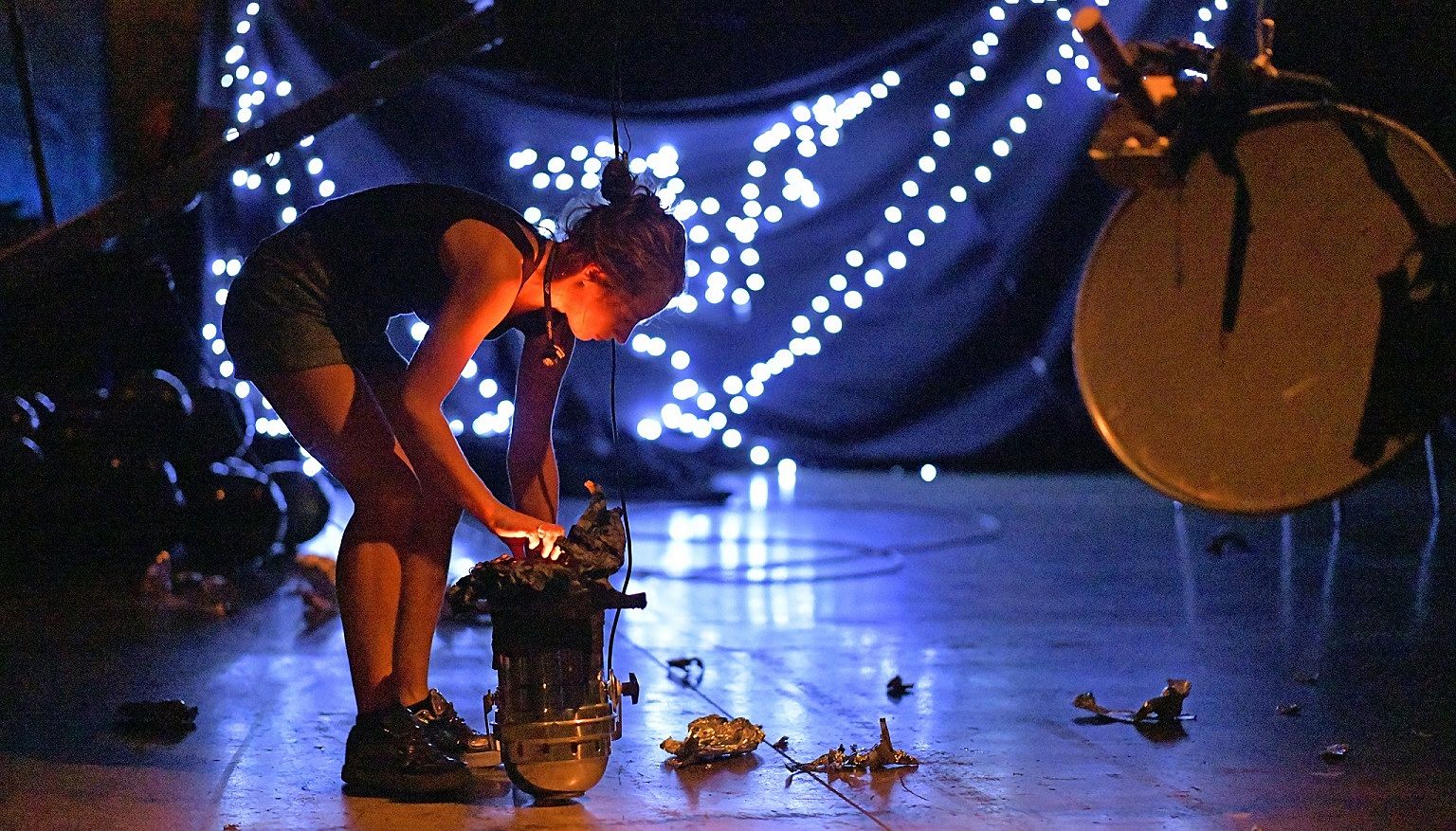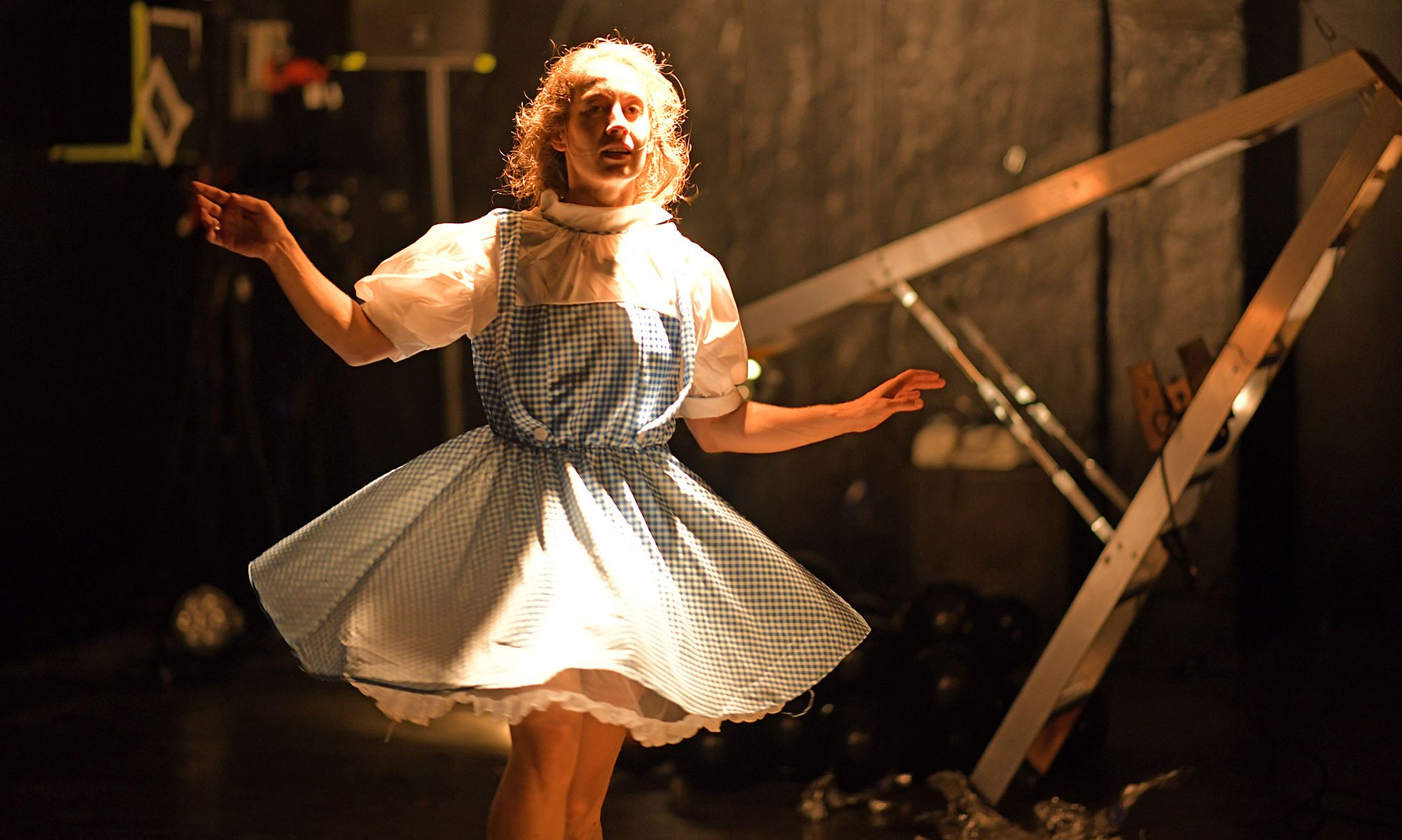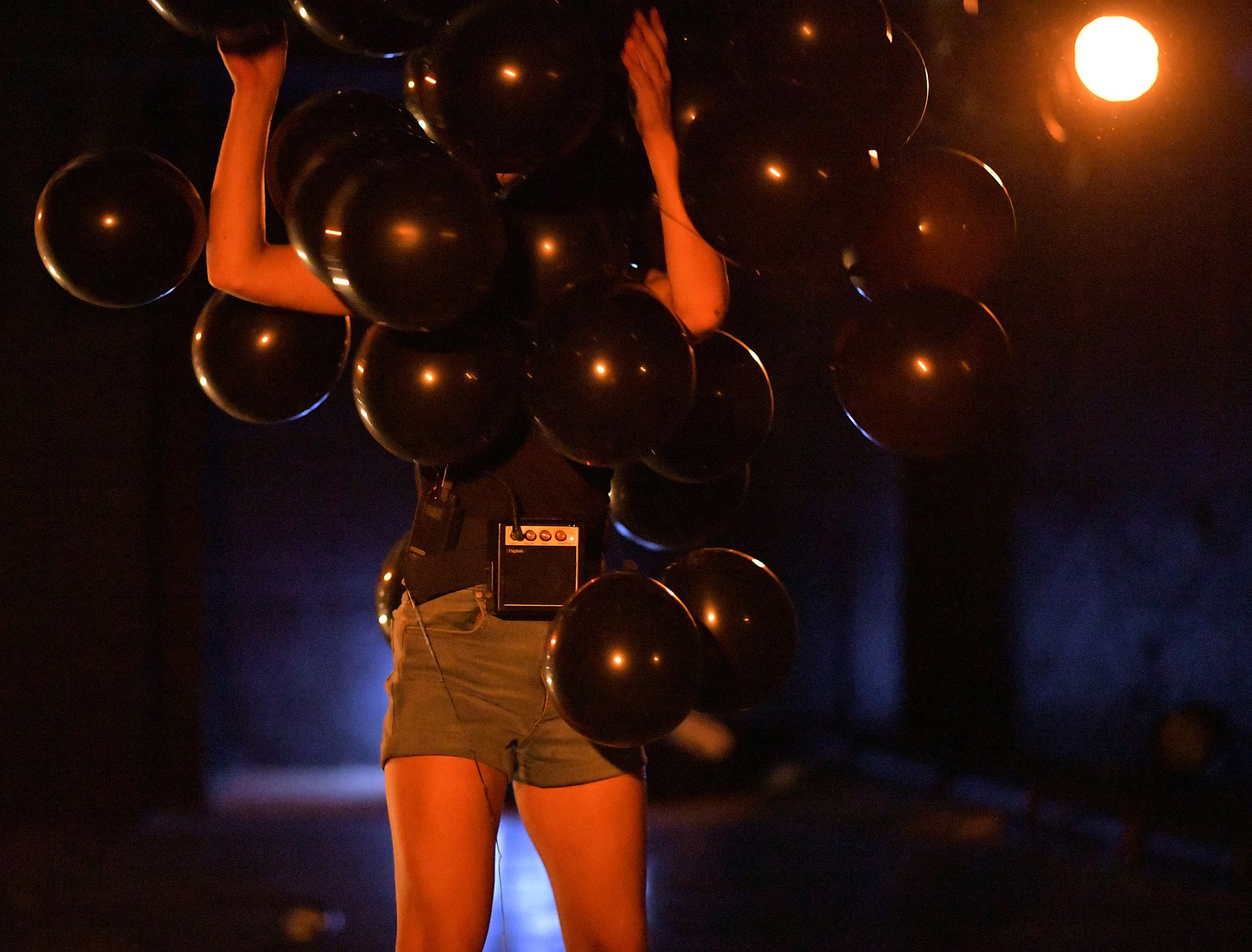Feminist Futures: A Review of Working On My Night Moves
New Volumes critic India Essuah heads into darkness with Working On My Night Moves, a new performance work from Julia Croft and Nisha Madhan that challenges us to imagine a world radically reshaped around feminism.
New Volumes critic India Essuah heads into darkness with Working On My Night Moves, a new performance work from Julia Croft and Nisha Madhan that challenges us to imagine a world radically reshaped around a bold and powerful feminism.
Every year my primary school held a school fair, and every year the Year Four classroom was turned into a maze for it. The year I was in that class, I remember watching as the space we spent nearly every day learning in was darkened and divided, transformed from reassuringly familiar to totally alien. When it was finished, we exchanged a gold coin for a chance to scurry through its tunnels, each sparse beam of light a relief as we rushed through its inky twists and turns. It was impossible to convince yourself that you were somewhere you’d been before.
When we started class again, we settled into the same old routines, but they now took place amid small changes. Tables were rearranged slightly, shelves were a little more to the left. Some differences were almost unnoticeable. We all felt slightly suspicious of the space which we’d briefly seen come alive, but we were also made aware, probably for the first time, that the class had to be consciously put back together, that it hadn’t just appeared out of nowhere. That we could change it.
I’m reminded of that maze as we enter the theatre for Working On My Night Moves at The Basement. Dark fabric has been hung across the edge of the space, sectioning off most of the theatre. We stand in a huddle and watch a seemingly-dismembered hand reach through from the other side of the wall, tweaking a set of lights.
All of a sudden, the black curtain drops. The theatre is a shadowy space stripped of all “conventional seating”, almost bare apart from a pile of ladders and chairs in one corner and a sound desk in another. It’s a lo-fi scene of light and dark, of anticipating the unexpected, and it conjures a strange, uncanny magic. Further, by breaking even simple theatrical conventions – like stripping out the seating and having us stand, for example – it foreshadows the show’s central idea: to build a feminist future, we’re going to need to step into the unknown.
Developed during time at London’s Battersea Arts Centre and the first of two shows in The Basement Theatre’s ‘Visions’ programme, Working On My Night Moves would be at home just as much in an art gallery as a theatre. Directed by Nisha Madhan, Night Moves sits alongside the last two performance art works by performer Julia Croft, Power Ballad and If There’s Not Dancing at the Revolution, I’m Not Coming, to form a feminist trilogy. While those last instalments broke down the limits of patriarchal language and the representation of women’s bodies in pop culture, Night Moves is less occupied with reframing and interrogating familiar debates around feminism and art. Night Moves wants to start from scratch.
Croft meets us after the curtain drops, pulling a stage light across the bare floor. She moves on to bigger pieces of furniture, hauling ladders and piling up chairs, building and rebuilding the bare bones of her set, driven by a design she feels no need to explain There’s an exciting novelty in watching her move and construct strange new scenes, similar to the novelty of seeing a woman eating on screen when she’s not in the middle of a break-up or breakdown – a straightforward physical action that we rarely see women do on stage.
As an audience, we are free to move about the room as she builds, a method for dispersing power in the room. But by breaking the usual divide between us, it quickly becomes clear that Croft is in full command of the space – the power dynamic is clear every time an audience member moves out of the way for Croft so she can move something behind them. It makes me wonder if Croft has ever lost a game of sidewalk chicken, but it also demonstrates that even as Croft is actively deconstructing the hierarchy in the room, we’re inadvertently propping it up. Who knows what might happen if we didn’t.
Night Moves is less occupied with reframing and interrogating familiar debates around feminism and art. Night Moves wants to start from scratch.
Night Moves is a predominantly physical work – the only language comes from recordings of physicists or academics – and the show’s enjoyable sensory elements re-package dense academic theory into something lively and tangible. The show draws on the work of writers who are interested in technology’s ability to disrupt traditional and natural ideas of biology and identity, and Night Moves takes elements of science and uses them for play. I’m transfixed by a bunch of black balloons buzz like angry atoms around Croft’s obscured head, bouncing off one another and catching the light to create mesmerising patterns, before she begins popping them with the heat of a light. In another, Croft wraps herself – constructs herself – in swathes of tinfoil before peeling the layers off in front of a fan, her shiny tinfoil skin dancing of its own accord to The Killers’ Human.
Te Aihe Butler and Jason Wright’s unpredictable soundscape leads us from lighter, joyful moments, such as the catchy title track, to the tensest parts of apocalyptic sci-fi, sometimes crackling from a radio that Croft’s wearing or from a satellite that she’s wielding. The sonic equivalent of a new light being turned on, our focus shifts constantly as we scan the room for the source of new layers of sound which seem to emanate from both inside and outside the theatre, building until the room is soaked in noise. Croft and Madhan have a knack for crafting combinations of sight and sound in the most unsettling ways; a writhing performance to a dubstep remix of Enya’s rendition of the Titanic’s My Heart Will Go On, for example, melted into a violent combination that left me feeling queasy.
During these scenes, we as audience members take our cues from one another and find places to perch or sit, places to settle, relax and take in the new ideas and narratives forming in the space. But Croft, Madhan and their team continually switch up scenes, shifting the focus and tone, always keeping us on the brink of a new configuration or feeling. We’re pushed around the space, always moving, to the point that by the end of the show I was craving a seat. When the show’s final image rolled around, Croft and another performer clutching projectors that create ‘stars’, I was unsettled and slightly unsatisfied, especially following the intensity of the rest of the work.
Perhaps that’s because I was spending a lot of the show grappling with what I was being shown. Night Moves is built on the future-focused philosophy of Xenofeminism, a radical document advocating for feminist futurism. To make progress toward that future, The Xenofeminist Manifesto calls for an end to ‘outrage culture’ (which is perhaps why Croft has moved away from cultural criticism); instead, the Manifesto says that energy is better spent devising “superior forms of corruption.” Xenofeminism envisions a world free not from the injustices of our current economic and system but of the systems themselves, and where technology can be harnessed to defy traditional, binary ideas of gender, ability and reproduction that continue to be ‘justified’ through biology. Their manifesto explains their belief that nature should no longer be used to justify any form of inequity as inherently given or inescapable; “the ultimate task” is to engineer “technologies to combat unequal access to reproductive and pharmacological tools, environmental cataclysm, economic instability, as well as dangerous forms of unpaid/underpaid labour”.
Night Moves integrates these visions into its sound, its lighting (by Calvin Hudson) and its performance design (by Meg Rollandi) to create an immersive and disruptive spectacle. It’s not an easy entry point into a theory often criticised for its linguistic complexity; instead, it’s honest with us that the future is going to involve a fair bit of searching in the dark as we build new infrastructure and ways of thinking that have yet to be imagined. While there’s a kind of frustration that comes with seeing work that feels slightly beyond your realm of understanding, it’s a relief not to be told what the future of feminism is, or what exactly we should think. That would have felt a lot like taking a step backwards.
Within the performing arts, change seems to happen at a glacial pace. Industry figures fall under the weight of their own wrong-doings and so many can only focus on what the perpetrator stands to lose. Their power and objectification lives in the form of their work, too; more than 40 years ago, Laura Mulvey described this leering vision as ‘the male gaze’ in her book Visual Pleasure and Narrative Cinema. There are endless statistics and examples to draw on; I can see why Croft and so many like her are tired of taking tiny steps within an existing framework, where change feels incremental, stagnant, or even like it’s being unpicked.
While there’s a kind of frustration that comes with seeing work that feels slightly beyond your realm of understanding, it’s a relief not to be told what the future of feminism is, or what exactly we should think. That would have felt a lot like taking a step backwards.
Xenofeminism also says we can no longer accept “the reification of the given masked as critique”, and the show’s complexity and openness felt particularly pertinent while absorbing International Women’s Day through my phone. On a day that’s supposedly about progress, real examples of this focus were few and far between.
I saw the breakfast drink company Up & Go mark the day on their Instagram; I was served it as a sponsored post. I also saw a marketing agency post a pixelated photo of a naked Barbie doll with muscular arms, captioned ‘Enough said’. And I saw the New Zealand Police post a (now deleted) tweet about a woman who managed a concentration camp for Japanese women and children during World War II. “Sorry if we offended anybody with our last tweet,” they said in their ‘apology’. “We are wanting to show how far we have come. The timeline was put together for the celebration of 75 years of women in police.” Strange, empty, grotesque things happen when feminism is warped, watered down and served up as a form of marketing.
Watching shows that forge new ground and searching for meaning within them is no walk in the park – not to mention the reading on agential realism or Xenofeminism that those shows may propel you to afterward. But Working On My Night Moves is a meaningful antidote to the vapid narratives of ‘progress’ that increasingly stand in for the real thing. Croft, Madhan and their team have created something that’s frequently uncomfortable, but that discomfort carries its revolutionary intent: stepping into the unknown can be disorienting, but it feels a lot better than moving backwards.
Working On My Night Moves runs from March 6 to 23 at Basement Theatre. Tickets available here.
This piece is presented as part of our New Volumes critical writing partnership with Basement Theatre. Basement Theatre covers the costs of paying our writers while we retain all editorial control. You can read more about the programme here.




